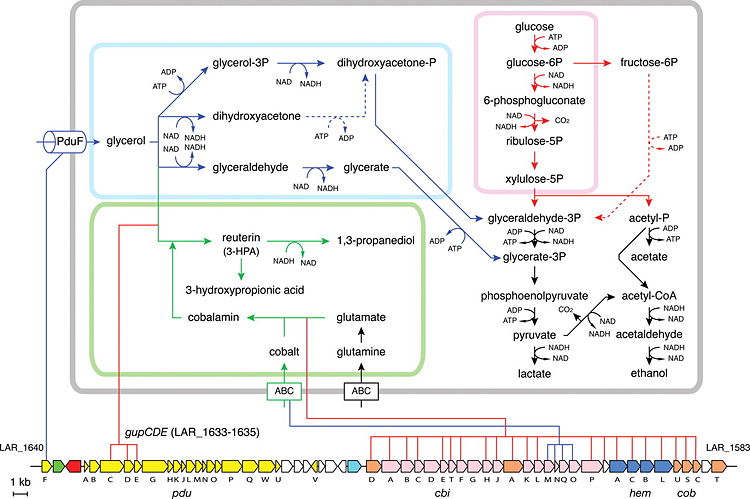Lactobacillus reuteri: Difference between revisions
| Line 22: | Line 22: | ||
Lactobacillus reuteri is a Gram-positive rod that forms chain arrangements and does not produce endospores. Some strains have also been shown to form relatively thin biofilms (5-7µm thick.) [1] L. reuteri is a mutualistic host-associated microbe, living in the guts of animals. As such, it requires a host habitat and is a mesophilic, facultative anaerobe with a preference for acidic environments. L. reuteri is an obligate heterofermentative microbe, producing carbon dioxide, ethanol, acetate, and lactic acid from glucose fermentation. It can also anaerobically metabolize glycerol, producing the antimicrobial reuterin (3-hydroxypropionaldehyde). [2] L. reuteri has also been shown to produce folate and cobalamin, also known as vitamin B12, nutrients that many animals, including humans, require. | Lactobacillus reuteri is a Gram-positive rod that forms chain arrangements and does not produce endospores. Some strains have also been shown to form relatively thin biofilms (5-7µm thick.) [1] L. reuteri is a mutualistic host-associated microbe, living in the guts of animals. As such, it requires a host habitat and is a mesophilic, facultative anaerobe with a preference for acidic environments. L. reuteri is an obligate heterofermentative microbe, producing carbon dioxide, ethanol, acetate, and lactic acid from glucose fermentation. It can also anaerobically metabolize glycerol, producing the antimicrobial reuterin (3-hydroxypropionaldehyde). [2] L. reuteri has also been shown to produce folate and cobalamin, also known as vitamin B12, nutrients that many animals, including humans, require. | ||
Figure 1: Proposed metabolic pathways of Lactobacillus reuteri | |||
Figure 1: Proposed metabolic pathways of Lactobacillus reuteri [2] | |||
[[Image:Reuterimetabolism.jpg|750px|]] | [[Image:Reuterimetabolism.jpg|750px|]] | ||
Revision as of 16:36, 26 April 2009
Classification
Domain; Phylum; Class; Order; family [Others may be used. Use NCBI link to find]
Species
|
NCBI: Taxonomy |
Genus species
Description and Significance
Describe the appearance, habitat, etc. of the organism, and why you think it is important.
Genome Structure
Describe the size and content of the genome. How many chromosomes? Circular or linear? Other interesting features? What is known about its sequence?
Cell Structure, Metabolism and Life Cycle
Lactobacillus reuteri is a Gram-positive rod that forms chain arrangements and does not produce endospores. Some strains have also been shown to form relatively thin biofilms (5-7µm thick.) [1] L. reuteri is a mutualistic host-associated microbe, living in the guts of animals. As such, it requires a host habitat and is a mesophilic, facultative anaerobe with a preference for acidic environments. L. reuteri is an obligate heterofermentative microbe, producing carbon dioxide, ethanol, acetate, and lactic acid from glucose fermentation. It can also anaerobically metabolize glycerol, producing the antimicrobial reuterin (3-hydroxypropionaldehyde). [2] L. reuteri has also been shown to produce folate and cobalamin, also known as vitamin B12, nutrients that many animals, including humans, require.
Figure 1: Proposed metabolic pathways of Lactobacillus reuteri [2]

Ecology and Pathogenesis
Lactobacillus reuteri is a naturally occurring component of the animal stomach and intestine microflora. L. reuteri has not been known to be pathogenic; rather, it has been studied as a probiotic organism. L. reuteri produces reuterin by fermenting glycerol. [2] Reuterin is a broad-range antibiotic, affecting both Gram-positive and Gram-negative species, that most pathogenic intestinal bacteria are sensitive to. Studies have shown reuterin produced by L. reuteri is useful against a wide array of harmful bacteria such as pathogenic E. coli strains, Clostridium difficile, Salmonella enterica, Vibrio cholerae, and many others. [3, 4] While it is known how reuterin is produced, the mechanism of how reuterin inhibits growth of such a broad range of pathogenic microbes is still unclear. The antimicrobial ability of L. reuteri is also contributed by its colonization of the epithelial cells, preventing other bacteria from colonizing. Studies have shown that some strains of L. reuteri may prevent Heliobacter pylori infection, the main cause of gastric ulcers, via colonizing competition. [5]
L. reuteri's ability to produce the nutrients folate and vitamin B12 have also been studied as a possible nutritional supplement. Humans require daily intakes of both of these nutrients, and vitamin B12 deficiency has been linked to heart disease, anemia, cancer, and other problems. Vitamin B12 deficiency is particularly prevalent in people with strict vegetarian diets, where supplements of L. reuteri would be useful. [6]
References
Author
Page authored by _____, student of Prof. Jay Lennon at Michigan State University.
